Gotham Academy, one of the critical bright spots of the DC lineup, is about to get some new artistic talent on board for a short time. Series co-writer Brenden Fletcher announced on a panel today at NYCC, that the Gotham youth-focused series, in its second year, will be shifting into the teenage side of the […]
Viewing: Blog Posts Tagged with: Brenden Fletcher, Most Recent at Top [Help]
Results 1 - 8 of 8
Blog: PW -The Beat (Login to Add to MyJacketFlap)
JacketFlap tags: DC, Top News, gotham academy, Brenden Fletcher, NYCC '15, Add a tag
Blog: PW -The Beat (Login to Add to MyJacketFlap)
JacketFlap tags: Interviews, DC, DC Comics, Top News, Brenden Fletcher, dragon-con, Add a tag
Brenden Fletcher is one of most unique voices in superhero comics and easily one of my favorite writers at the Big Two. Along with fellow writers like Steve Orlando, Ming Doyle, Tom King and David Walker; Fletcher is leading a charge that is creatively rejuvenating DC and giving the publisher its best line-up of titles […]
Blog: PW -The Beat (Login to Add to MyJacketFlap)
JacketFlap tags: Television, DC, Cartoons, Archie, Bruce Timm, Mark Waid, Jimmy Palmiotti, Alex Segura, Top News, mark russell, Amanda Conner, tim seeley, Tom King, Roberto Aguirre-Sacasa, SDCC '15, Brenden Fletcher, Justice League: Gods and Monsters, Rick & Morty, the awesomes, Chad Hardin, Add a tag
Here’s where I finally release what’s left of our SDCC audio content…as a follow-up to last week’s set of DC and Marvel Television interviews, here are our chats on the animated side of things including discussions with Dan Harmon, Justin Roiland, Bruce Timm, Andrea Romano, Ike Barinholtz, Seth Meyers, and more! Additionally, here are the audio […]
Blog: PW -The Beat (Login to Add to MyJacketFlap)
JacketFlap tags: DC, Conventions, Fashion, SDCC, Batgirl, jim lee, Todd McFarlane, Cameron Stewart, Top News, Karl Kerschl, Top Comics, SDCC '15, Erik Larsen, gotham academy, Babs Tarr, Brenden Fletcher, Batgirl of Burnside, Hank Kanalz, Jim Valentino, Interview, Interviews, Comics, Add a tag
At SDCC '15 I talked with the Burnside Batgirl crew about their creative origins, how the look that launched a thousand cosplays came to be, how to handle creative criticism, and their earliest con experiences.
Blog: PW -The Beat (Login to Add to MyJacketFlap)
JacketFlap tags: Comics, DC, DC Comics, Black Canary, SDCC '15, gotham academy, Brenden Fletcher, Interviews, Add a tag
By Harper W. Harris
The Fletcher-Verse: this is what superfans like to call the little corner of the DC Universe that’s penned (or co-penned) by Brenden Fletcher, including Batgirl, Gotham Academy, and the new Black Canary series. I got a chance to sit down with Brenden to discuss his inspirations, approach, and general disregard for continuity in Gotham Academy and Black Canary.
Harper W. Harris: I’ve heard that Miyazaki is a big influence on what you’re doing with Gotham Academy. What parts or aspects of those movies did you want to bring into Gotham Academy and the tone?
Brenden Fletcher: I wouldn’t say that my love of Miyazaki is something that I’m trying to put on the page of Gotham Academy, or of any of my books. But discovering Miyazaki at a young age and his Studio Ghibli films really transformed my view of what it meant to tell a story, and how to approach character and drama. I think that’s what I’m trying to bring to all of this, I’m just trying to be mindful of his approach. These books are completely different from anything he’s done. So I’m hoping that when people are examining what we’re doing with that in mind, they’re not trying to look for specific elements or anything. I will say this however: I believe that what we have in common more than anything is the fact that we seem to be drawn to tell stories about female protagonists. If you look at most of Miyazaki films…[A saxophone plays in the distance] I’m sorry, that’s “Careless Whisper” on the saxophone being played at San Diego Comic Con. You don’t expect Wham on a Friday morning.
HH: No, it’s a little early for that!
BF: But yeah, I think I haven’t really figured out why it is I’m drawn to telling stories with female protagonists, but this has always been the case. Since I started writing, every story that I’ve felt connected to has had a female protagonist. I don’t do it on purpose, it’s just what interests me.
HH: So switching over to Black Canary for a second, that obviously draws from a very different creative pool than Gotham Academy, one that you have some personal experience with. How does your experience as a rock musician inform the way you write that book and formed that character?
BF: Yeah I’ve been playing music all my life. I’m primarily a singer; I went to school for music, studied voice and classical singing. I ended up doing musical theater for years, and on the side I was always playing in bands. At one point in my life I decided I didn’t like the formal aspect so much, so I wanted to get out of classical. I wasn’t really into the musical theater scene; I liked the jobs, but it wasn’t really me. So I spent more time writing music and playing music, and working on being a better instrumentalist and that turned into some touring and getting involved in the business of music. This was never something that I could make a living out of, I didn’t become a world famous musician, but I experienced enough of the life to inform this new world I’m building for Dinah Lance in the new Black Canary book.
HH: With Gotham Academy you’re co-writing with Becky Cloonan. With co-writing, I’m always curious about the process–what is the process like writing with Becky?
BF: It’s interesting: I think we could talk about it in terms of how Becky and I work, but this is a full team effort and Karl [Kerschl] is in on the story building at every phase of the project. We start usually by going out for a coffee–I’ve got some ideas, Becky’s got some ideas, Karl’s got some ideas. We turn that into a look at where the story should be going, and at that point Becky and I create a breakdown of the issue, what the twenty pages will roughly look like. We give that to Karl, he tells us we’re wrong and we have to back and retool it until he’s happy with it. From there we give it to the editors who sometimes tell us we’re wrong. Eventually we get to scripting, and that’s another stage where Karl will fix things or tell us things are wrong–or sometimes he just doesn’t, and I’m not even kidding you, he’ll just change things on the page, just draw where he thinks it should go, and 100% of the time he’s right. Karl is an extremely gifted storyteller, great writer, an Eisner award winning writer/artist. What we have is this incredible merging of visions–actually I think we share a vision, but we merge our talents and abilities and our individual ideas to become this wonderful thing that’s Gotham Academy.
HH: It sounds like Gotham Academy is a really collaborative effort, that’s great. So when you’re writing a script for different artists, so for example writing for Annie Wu on Black Canary, how is your scripting style different?
BF: Totally different. The only reason I’m writing full scripts for Gotham Academy is because I’m collaborating with Becky and because the office requires it–they like to see a full script. With Karl, we can pretty much get on the phone and say, yeah, page twenty looks like this, and he’ll deliver it and it’ll be perfect. Annie and I had a talk early on about how she likes to approach things, and she had been working with Matt Fraction on Hawkeye for a while and wanted a script that was closer to what Matt was doing. So this is the first time that I’ve written closer to what is known as the Marvel Style. Annie wants a looser breakdown of what the pages looks like with some script beats in there. She can push and pull those things as she wants, she adds beats, moves beats, but ultimately the core of the story I’m trying to get across, the core of the movement of the characters is all there on the page.
HH: When you first started out with Black Canary, were you able to pick and choose what aspects of her past you wanted to use? Given that it’s not your average superhero story, have you found it challenging to tell the story you want to tell within the confines of continuity?
BF: I have a relatively clean approach to continuity, which is just that I ignore everything that I don’t like. I will never contradict it to the best of my ability, but if something feels off to me I’ll try my best to avoid it. I am playing into a lot of the New 52 continuity for Dinah Lance, but using it for very specific reasons which you’ll see over this first arc. I’m trying to bring it all together and make it make sense in a way that makes Dinah feel like the iconic version of the character that we know and love.
HH: She’s a welcome member to the ever-growing Fletcher-verse!
Black Canary #1 and Gotham Academy #8 are on shelves now, with new issues coming in the next few weeks!
Blog: PW -The Beat (Login to Add to MyJacketFlap)
JacketFlap tags: Brenden Fletcher, review, Reviews, Comics, DC, Becky Cloonan, Top News, gotham academy, Add a tag
Gotham Academy #6
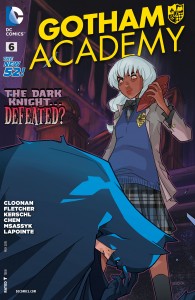 Story: Becky Cloonan, Brenden Fletcher
Story: Becky Cloonan, Brenden Fletcher
Art: Karl Kerschl, Mingue Helen Chen
Color: Msassyk, Serge Lapointe
Letters: Steve Wands
Publisher: DC Comics
As much as we love reading about the adventures of the world’s greatest detective, you have to figure Gotham city is probably a pretty messed up place to grow up. Walking down the street could get you turned inside out by Joker gas or someone in a skintight cat outfit could shred you to pieces. Even adolescents in this world have it rough. This is mostly due to Becky Cloonan and Brenden Fletcher. They put kids in buildings with Arkham inmates, fire hazards, and sinister looking headmasters. All these obstacles put forth for our enjoyment in Gotham Academy #6.
The issue wraps the first story arc and sheds a little more light on Olive Sliverlock’s forgotten past. What issue six finally does is make good use of a Batman appearance. It’s powerful, and not just because of the fight with Killer Croc. This chapter of Gotham Academy puts Olive on a collision course with the caped crusader. Neither character is shown to be on the right side of the argument, which makes this matter poignant to the series and a mystery we’re sure to want answers about. Cloonan and Fletcher write the usual whimsy and angst sprinkled voice that cast of characters has become known for in the series. It’s just that now the team has managed to raise the stakes for all of them.
In addition to the usual fantastic Disney animated style art of Karl Kerschl, issue six brings Mingue H. Chen on board for some key flashback sequences and an epilogue that leaves us wishing DC would just skip Convergence altogether. Her style is noticeably more painted than that of Kerschl but it never jitters the reader. The two artists blend pages smoothly and that’s the best you can ask for when sharing illustration duties on a single story.
Gotham Academy is one of the best new ideas DC has published in awhile. If you’ve been on the fence about trying this series, go do it. Issue six, as a standalone, has major hook and you’ll definitely be enticed enough to pick up the pieces you’ve missed. One usually has to read a Vertigo published book to find this much depth in a comic.
Now that the kids are united it’ll be even more fun to see how they’ll be divided.
Blog: PW -The Beat (Login to Add to MyJacketFlap)
JacketFlap tags: Comics, DC, Top News, review, DC Comics, Becky Cloonan, Karl Kerschl, gotham academy, Brenden Fletcher, Reviews, Add a tag
By Davey Nieves
Gotham Academy #4
Story: Brenden Fletcher, Becky Cloonan
Art: Karl Kerschl
Color: Msassyk, Serge LaPointe
Letters: Steve Wands
Publisher: DC Comics
Written by Becky Cloonan(DEMO, Killjoys) and Brenden Fletcher(Batgirl, Assassin’s Creed), Gotham Academy #4 continues its mystery as young Olive Silverlock uncovers the ghost of the north hall. The academy itself is much like Gotham City, written with an atmosphere that makes it feel living but never outshines the characters. Along the way Olive’s relationship with her ex-boyfriend Kyle continues to reach a breaking point as a possible new interest literally catches her. It’s not just her love life that’s bending. Like any young girl, Olive finds fitting in has challenges of its own. In this issue her self-esteem will be tested as she stumbles upon gossip she might not be ready to deal with. Readers are enticed with more details as to Silverlock’s forgotten summer and the burning question of what happened to her mother. These pages flow so well together that once you hit the end of the book it feels like a crime not to dive right in to the next issue. One of the very few minuscule problems I’ve had with the series is the way issues leave readers on a cliffhanger but subsequently pick up moments after it in the next chapter. Hopefully with the major punch this issue ends on that won’t be the case for issue five.
While the book is a rich ensemble full of unique voices from Olive’s sister figure the spunky young Maps all the way through to Headmaster; issue four is more Olive’s book as you really see her three sides. Who she is among friends, who she is to herself, and the part of her she doesn’t know. Moments in the book like her confrontation with the “ghost” of Jane Cobblepot illustrate it best.
Gotham Academy is consistently a pretty book. It plays with a Manga influence that in most other American titles would be a deterrent. Karl Kerschl’s (Majestic, Teen Titans) line work is the first part of this recipe. Where a lot of Manga-style books stumble is in the framing of their shots. Kerschl’s work doesn’t suffer from that one bit as everything feels like a natural camera position. When you add the colors of MSASSYK and Serge LaPointe it makes the page vibrant in a way few books are. The end result feels like a hybrid of Anime, cinema, and emotional Disney animation.
The series isn’t without imperfections of its own, since the first issue there’s a stumble that merely tugs on you in the way a fly tugs on an elephant. It probably only knows it’s there but doesn’t really ruin their day. Gotham Academy has so many moving parts that some thing feels as though it falls by the waste side when I’ve seen it. Bruce Wayne’s brief appearances; they almost feel shoehorned in. Granted the book is only in the orbit of the Batman universe by association, but that means the series should get to a point where it only needs Bat appearances when absolutely necessary. It’s a minor complaint that does little to hinder the enjoyment overall, but you know… internets.
Growing up in the 90’s, for me it was all about: Batman: The Animated Series, Pepsi, and the band Rancid. Perhaps what stood out to me most about TAS was how much I cared about the players who weren’t Batman. Two-Face, Leslie Thompkins, one and done Charlie Collins, even Gotham City itself were all stories I invested in. As of late, Bat group editor Mark Doyle has added books to the bat-ecosystem that have captured a similar type of magic previously only on Fox Kids programing. Gotham Academy has been an underrated prime example of it. Issue four continues its unfolding of the institution’s connection to Gotham’s lore through the lens of adolescence.
Ultimately, Gotham Academy is a niche audience book that outstretches its boundaries by being energetic and refreshing. While its Young Adult nature might not appeal to the hardcore superhero crowd; there’s a good story about a troubled girl trying to find herself, which in a way makes her relatable to millions of people out there. If the Gotham Academy team is a band, then issue number four is their Let’s Go. What’s scary and exciting about that is the possibility that issue five could be their And Out Come The Wolves. For the non-punk rock fans out there, what that boils down to is Gotham Academy #4 figures out the strengths of the series. Issue five could be where everything fires on all cylinders and I have no doubts that it will be a book I can enjoy being a 72yr old man and then pass on to my adolescent niece. In short the definition of all age storytelling.
If words like Gretzky, Clutch, Zayn, and Archie are in your vocabulary then feel free to follow and unburden your anger at Dave on twitter @bouncingsoul217
Blog: PW -The Beat (Login to Add to MyJacketFlap)
JacketFlap tags: Comics, DC, Commentary, Batgirl, Big Two Comics, Cameron Stewart, Top News, Top Comics, Babs Tarr, Brenden Fletcher, Add a tag
This is obviously prefaced with a heaping helping of “what the hell does a straight white male know about these issues?”. The simple truth: I don’t know anything. I likely never will – or at least not in a way that can be internalized. At best, I can gather other people’s feelings and memories and keep them in my brain for reference, paging through as I react and respond, because… well, I might not know anything about this, but I think that reaction and response is important instead of choking the fire of discussion dead through inaction.
So. Batgirl #37.
The new creative team on Batgirl arrived with a certain amount of pomp and circumstance. Briefly bringing my experience as a retailer into the fray, the fervour was created almost entirely by the creative team themselves, and not the company publishing the book. A book lives on finding an audience and marketing to that audience, and while DC did eventually run a house ad steeped in current social media trends, it was the creative team that was actually out on social media sites stirring the fan base and building a culture. At the time, I remember thinking that this was something important – not only in the way the creatives were interacting with the fans, but in the way that the reaction seemed to transform into a small movement of sorts, one that would boost sales of a series through actual interest in tone and content. This week, it seems as though the shine is off that apple with the release of the team’s third issue, Batgirl #37.
In the issue, Barbara Gordon is confronted with another Batgirl, one that is using social media and various forms of “art” to essentially take her branding identity away from her. Over the course of the book, you discover that the person under this fake Batgirl’s mask is in fact Dagger Type, an artist who is identified by characters in the story as male. Babs is taken aback by this and is left defeated as the issue’s villain continues with their nefarious plan to steal her public identity.
As the book crescendos, Dagger Type is portrayed as erratic, firing a gun into a crowd of essentially innocent bystanders. Babs eventually defeats the villain, and discovers that they’ve been doing this at the behest of a mysterious benefactor. The cops take Dagger away, and the book draws to a close. This reading of Batgirl #37 has dredged up accusations of transphobia. As with all art, this is a valid interpretation of fictitious events – a reaction to substance informed by opinion, experience and information. That’s a shame because… well, this book was meant to be something else. As stated before, it was something different than the norm, and marketed to a different and potentially new audience, and this misfire will probably do some damage. The only consolation, I would think, is that despite this valid interpretation of the comic, it isn’t something done with malicious intent, more than it was the unfortunate side-effect of the story’s plot.
Revisiting the plot again, using the same reference material, the plot is also about the nature of art, identity, and belonging. The book opens with the fake Batgirl going on a crime spree. Babs shows up and stops the crime, but not the fake Batgirl, who is said to have been up to these types of heists and behaviours for quite some time, chronicling these events on social media platforms. Babs is upset that she’s being defamed, which is compounded when she goes to a Dagger Type art show that features nothing but pictures of this so-called Batgirl, complete with a rendition of the heroine in a wheelchair, splashed with shadow and a bright red overlay. The presentation effects the characters present in different ways. It strikes Babs as demeaning and regressive. She makes a move to find Dagger Type, and soon discovers that the artist has been the fake Batgirl all along. The plot involves using art and social media to co-opt the Batgirl brand, and add it to the Dagger Type cache. When the reveal happens, everyone in the audience acts dismissive. Dagger waxes poetic about how they should relish in this moment, where they “begin to comprehend that the artist is really the subject. And the subject, his brand!” This elicits the greatest reaction from the crowd, who rejects this notion with lines like “why does everything cool turn out to be an ad?”
The intention – or at least my interpretation of the events as described – is a comment on art and commercialism, as seen through the lens of the modern superhero genre. It’s an ugly balance that comic companies (and retailers… hi!) have been trying to work with for years, taking art and using it for commercial gains. It’s an exploration of the kind of rejection that occurs when false notes are struck, and the commercial ends up bleeding into the art. It’s also about the pretension of craving attention, and the effect popularity can have on art and the artist. There’s a lot to dig into there, but at the core of it all, deep down in the nugget, I truly believe this book is about art, and the reactions to it. It’s typified by the scene where Babs and her friends are walking through the Batgirl gallery, and they all have different reactions to the presentation based off of experience. Babs’ very personal experience with the identity being explored in these photos elicits a very personal and valid response. I can only imagine that’s what many people felt as they read through this issue and experienced a similarly flawed take on identity. The issue essentially agrees with the idea of interpretation being in the eye of the beholder, and never once says that people who enjoyed the art installation in the pages of the book are wrong. It does cast judgement on intent. Dagger Type’s intent was self serving to a cartoonish degree, climaxing in rage when people didn’t understand his genius. I don’t think the creative team is doing that here. I think they wanted to turn in a story that commented on what they did, letting the art speak for itself. It may have said something things they didn’t intend, but they aren’t mad at anyone for it – as the issue implies, any reaction to art is valid.
Now, not long after I wrote this article (but a long while before it’s been posted), Cameron Stewart, Brendan Fletcher and Babs Tarr issued an apology.
Batgirl 37. We made mistakes. We’re deeply sorry. We will do better. pic.twitter.com/fCOEJPk0vP
— Cameron Stewart (@cameronMstewart) December 13, 2014
I wish Cameron Stewart, Brenden Fletcher, Babs Tarr and Maris Wicks all the best as they continue to explore this character and produce art for us to consume. I hope that it continues to challenge us, and causes discussion. I hope that discussion comes from an honest place, and is not confronted with reductive reasoning. I also hope that, like all great artists, they will continue to grow and learn from previous experiences and new information, as even the best intentions can be flawed. The best artists take those noted flaws and learn to grow, instead of digging their heels in. These people are some of the best. Oh, and one more thing:
If you didn’t think an apology was needed, the apology wasn’t for you.
— Cameron Stewart (@cameronMstewart) December 13, 2014



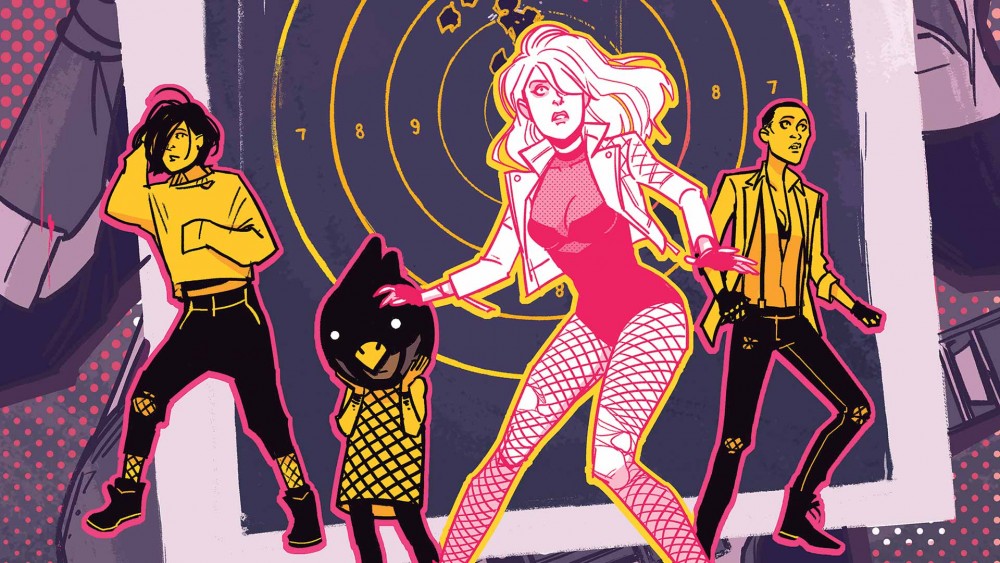
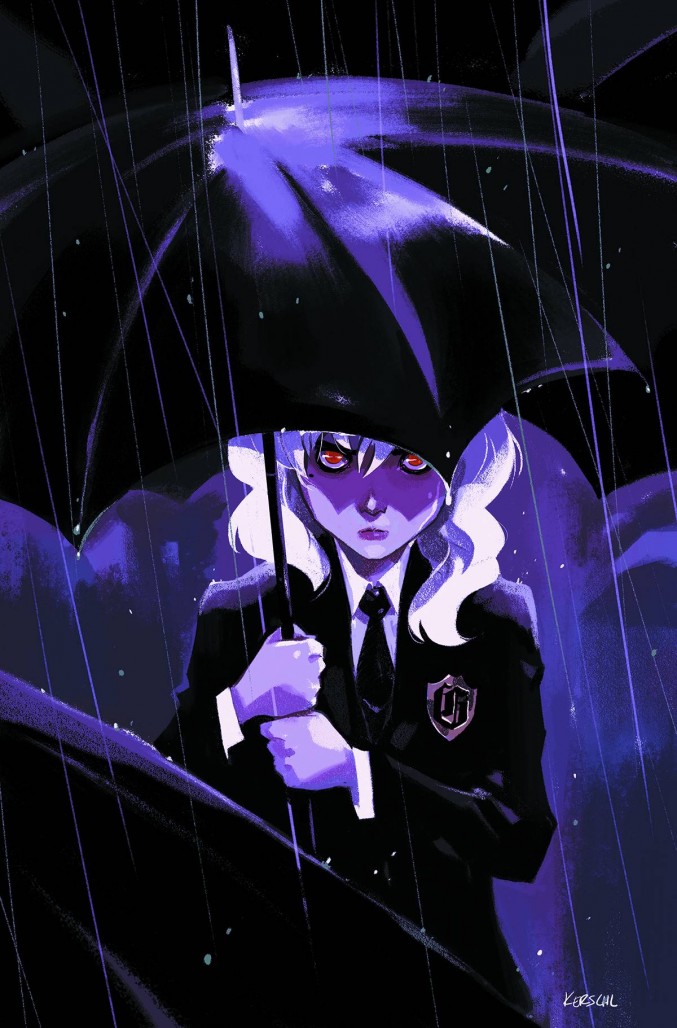
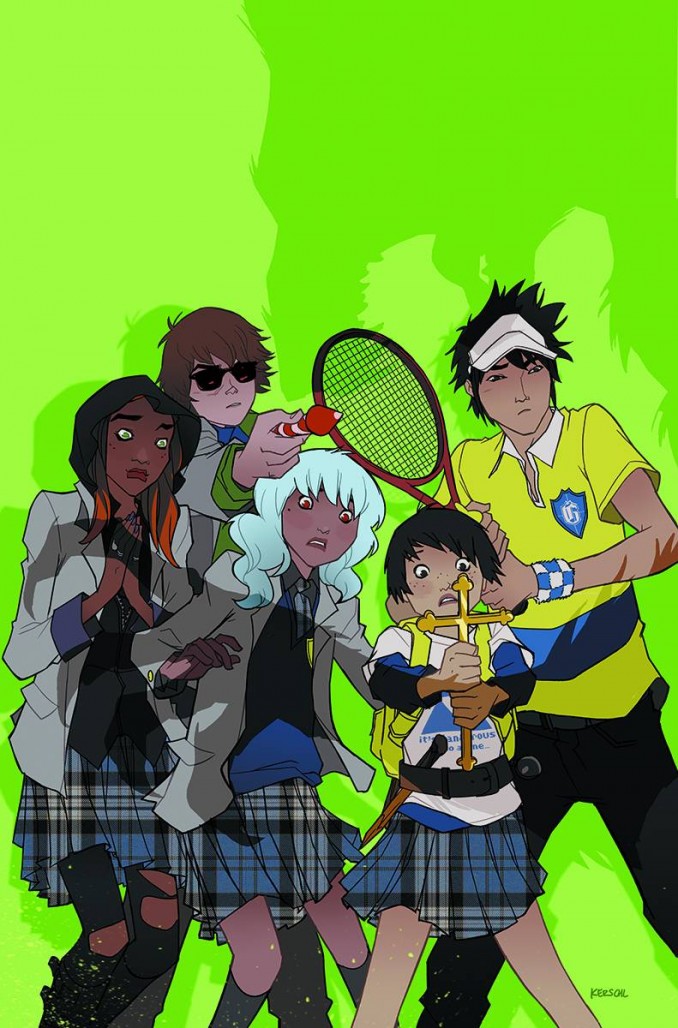
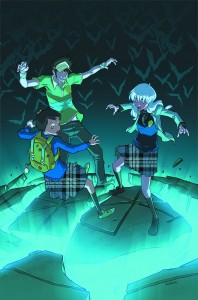


Nice, I dig your long form piece. I am interested in where this series is going, it seems to be building towards something.